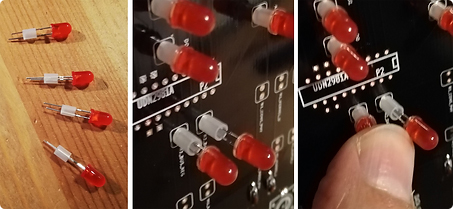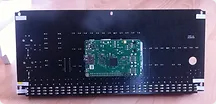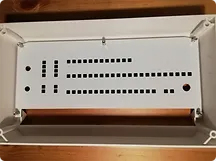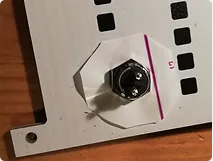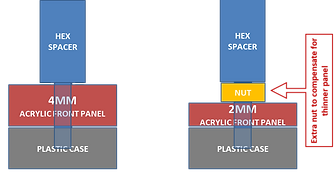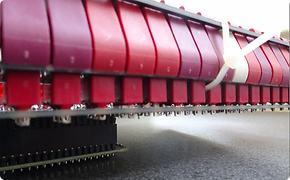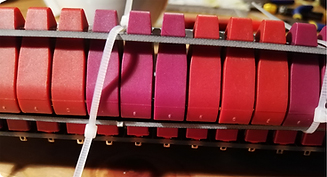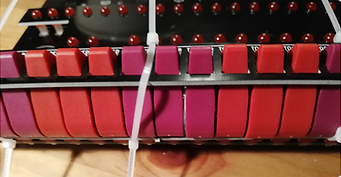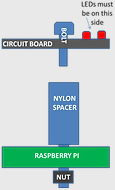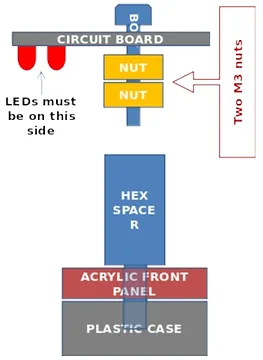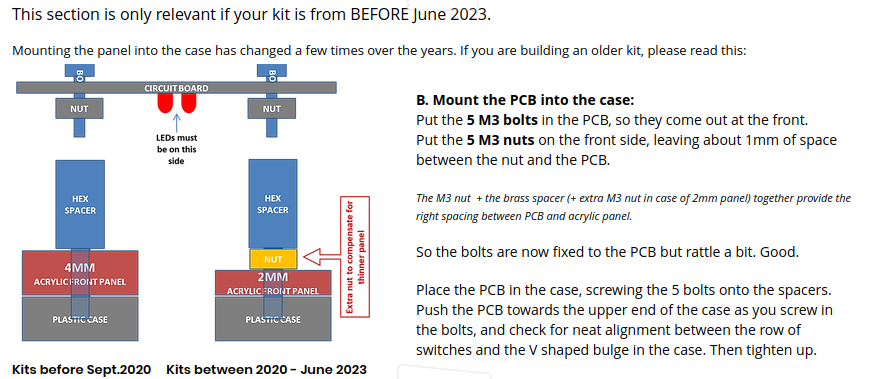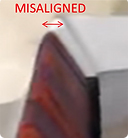Building the PiDP-11 should take about 6 hours. Tools required: Soldering iron, side cutter, Phillips screwdriver.
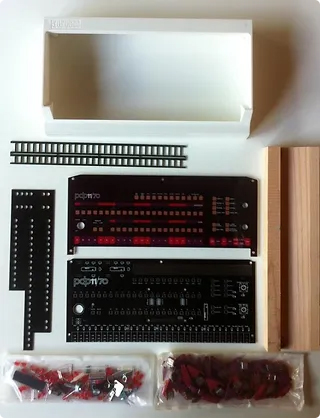
All kit parts, except back panel

The back panel
Parts list
- 1 PCB, 1 case, 1 acrylic front panel, 1 back panel, 1 base mount
- 11 red, 13 magenta toggle switches,
1 white, 3 red & 2 magenta momentary switches - 2 brackets (1 item, snap into two) to mount/support switches during soldering
- 64 red 5mm LEDs + 64 LED spacers to mount them higher on the PCB
- 1 shield to push LEDs into their exact space and keep them there
- 37 diodes
- 2 rotary encoders, 2 knobs
- 1 key switch with mounting nut and key
- 1 40-pin extra-height Pi connector
- 1 UDN2981A IC or equivalent & 1 IC socket
- 12 resistors (390 ohm), 6 resistors (1K ohm, or 820 ohm in recent kits)
- 5 M3 screws, 5 M3 nuts, 5 brass M3 10mm hex spacers to mount PCB
- After September 2020: 5 extra M3 nuts to add on the hex spacer, see below
- 4 M5 screws to mount back panel
- 3 M2.5 bolts, 3 M2.5 nuts, 3 M2.5 nylon hex spacers to mount the Pi
There are some spare parts in the kit, as well as some zip ties.
Important change in kits - please read
The Youtube construction movies do not show one important change in how the acrylic front panel is mounted in the white plastic case. It changed twice, over time. So please read that section on this page, it is important.
But specifically, in kits made from 09-2020 to 06-2023, the 5 brass spacers MUST be extended with a nut.
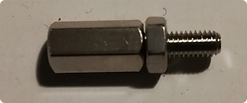
TL;DR?
Beige-o-Vision made a brilliant 4-part series on constructing the PiDP-11. Thank you, Colin! That work will save many hours for many people! You should of course read the detailed instructions below and certainly note the Important Change above, but to start:
The series pretty much describe all the things you should know. Only two comments from my side: First, you won't need to clean the solder pins of the switches, unless they are have a matte, dark sheen on them. Very unlikely, it occurred in an early batch of kits though. Secondly, it is best to put some more insulation between the Pi's USB connectors and the PiDP board. Sharp solder pins can pierce through tape, use a bit of cardboard.
Now for the detailed descriptions... but >>thank you!<< to Beige-o-Vision for the professional how-to video series.
1. Prepare your Pi
The pidp11 software runs fine without the PiDP-11 board plugged in. Set up & test your Raspberry Pi before you start soldering.
Any Pi from the Pi Zero up can be used. But a Pi 2, 3, 4 or 5 is recommended. Read the manual (link, open in MS Word or OpenOffice) for more important details. But for the new install process, follow the steps below :
There are two options; I recommend #2. Option #1 is for when - for whatever reason - you encounter setup problems..
Option #1: download the Raspberry Pi ready-to-boot SD card (it might take a while to download): SD card download link Alternate download using ftp: ftp.pidp.net; login as anonymous@pidp.net, then 'get pidp11.img.gz'.
Option #1 gives you the Lite version of the Raspberry Pi OS with the PiDP-11 software pre-installed. 'Lite' means no GUI, just the command line. But the PDP-11 boots up straight away, you never need to see any Linux. You can always add the GUI and other extras from the full Raspberry Pi OS later on, it's easily googled.
Write the pidp11.img.gz file to the SD card using the Raspberry Pi imager and you should be good to go. User: pi. Password: pi. It is configured to look for a wifi with SSID 'mywifi' and password 'password'. That's easily reconfigured but using a smartphone hotspot you'll be online quickly even if you are new to the Pi World.
Compatible with the Pi 5-4-3-2, and Zero 2/Zero 2W - every 64-bit compatible Pi in fact. Please let me know if you have trouble with the disk image, it is new as of Feb.22, 2024.
Option #2: Download the latest Raspberry Pi OS to your liking (64 bit is preferred), make sure to create the username 'pi', and bring the Raspberry Pi up to the point where you have an internet connection. Then:
sudo mkdir /opt/pidp11
cd /opt
sudo wget http://pidp.net/pidp11/2024/pidp11.tar.gz
sudo gzip -d pidp11.tar.gz
sudo tar -xvf pidp11.tar
sudo /opt/pidp11/install/install.sh
Follow the install script instructions, make sure to load the system disk images through the install script, and reboot.
(And yes, unzipping and untarring need to be separate steps, thanks to an arcane quirk of web hosting, never mind).
--------------------------------
After installing the Pi/PiDP11, reboot and:
- if your Raspbian is set up to boot into the command line, after login you will find yourself in the PDP-11 boot menu.
- if you're set up to boot into the GUI, open a terminal window and enter ~/pdp.sh to grab the terminal of the already running PDP-11.

Helpful to know: The PiDP-11 has its terminal connected to the Linux ‘screen’ program (link). This virtual terminal is then (automatically) connected to whatever device you happened to log in on. The PDP-11 is oblivious to whether you use serial, ssh, or a HDMI monitor.
If you are in the PDP-11, type CTRL-A d. You told 'screen' to leave the PDP-11 for the moment and now find yourself at the Raspbian CLI. You should read the manual, but because you won't: Pi’s must be properly shut down before powering off. Enter sudo shutdown -h now
This is also a good time to consider what terminal you want to use with the PiDP-11:
1. the Pi’s HDMI monitor and a USB keyboard,
2. ssh sessions wirelessly, if you enable that on the Pi. Enable VNC too and you get your GUI without any need for a HDMI monitor!
3. the PiDP board has a serial port. You can use a laptop or real terminal through that (link).
Later on, you can add up to 4 more serial terminals. But for now, testing using option 1 and/or 2 alone is good enough.
